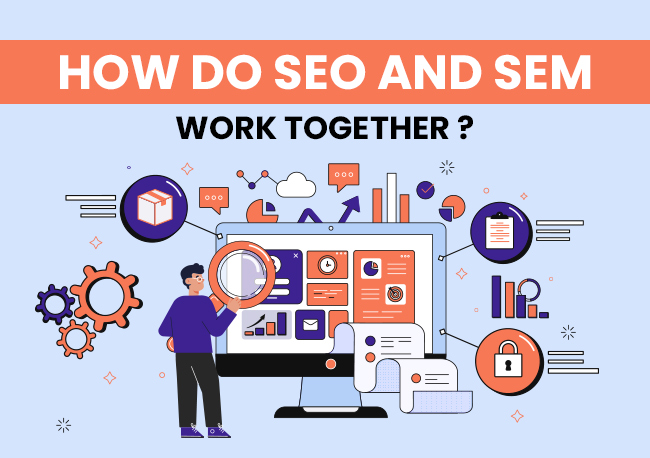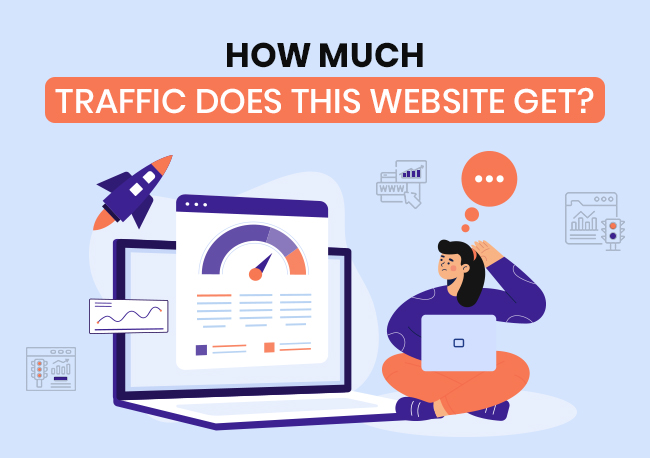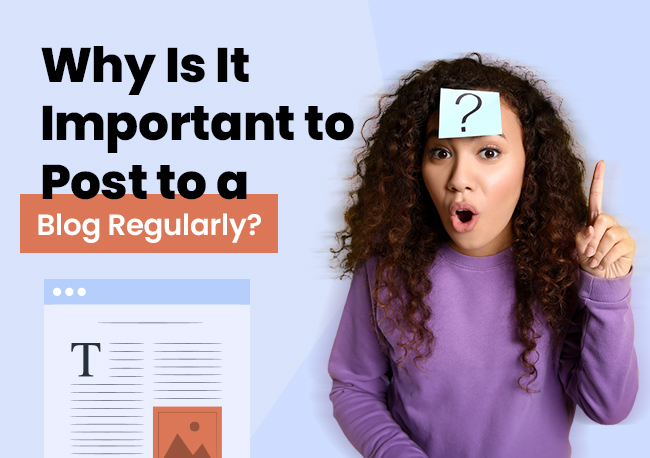| Getting your Trinity Audio player ready... |
You must frequently come across the terms SEO and SEM if you are involved with digital marketing. However, have you ever wondered what these two are and how they operate?
Consider digital marketing to be a mother with children. SEM and SEO are two of the many with distinctive characteristics and features.
Despite being from the same family, SEM and SEO serve different purposes. But before we get there, let’s define digital marketing and its importance for businesses.
Importance of Digital Marketing For Businesses
In the modern age of technology, digital marketing has become essential for a company’s success. Its significance comes in its capacity to engage with a sizable and varied online audience, allowing firms to get in touch with potential clients in a highly focused and economical way.
Digital marketing enables companies to improve their online visibility, increase website traffic, and ultimately enhance sales and revenue using tactics including search engine optimization (SEO), social media marketing, email marketing campaigns, and pay-per-click advertising.
Additionally, it offers useful data and analytics tools so that companies can track and evaluate the success of their advertising campaigns and make data-driven decisions for continuous growth.
Another important characteristic of digital marketing is its ability to adapt and respond to shifts in market conditions. Based on real-time data and customer feedback, businesses can quickly modify their strategy to stay competitive and relevant in a continuously changing digital market.
In a nutshell, digital marketing is not only an option for organizations; it is a necessity. It paves the way for growth, promotes brand recognition and adoration, and enables businesses to interact personally with their customers.
Businesses that adopt digital marketing not only survive but thrive in the digital era, where the online presence and customer engagement are key drivers of success.
Also Read: What Are The Benefits Of A Website For Small Businesses
What is SEO?
SEO is a component of the digital marketing family, also called search engine optimization, which enhances your website’s search engine visibility and improves ranking.
By using SEO to optimize your website with unique and educational content, you can raise traffic to your website and make it easier for your target audience to find your product or service.
One can strategically plan their campaigns with the help of SEO by creating valuable content appealing to readers.
We all know what SEO is by this point, but did you know there are several SEO practices you can include to help you succeed more?
Let’s find out!
Also Read: Top Industries That Can Benefit From SEO?
➢ Understanding the Various Types of SEO Practices & Strategies
1. On-Page SEO
On-page SEO involves the art of effectively enhancing different components on the website in order to boost its performance in search engine results pages. It involves a smart mix of technical SEO and content optimization, where we meticulously evaluate elements like the website titles, links, content, and various other factors.
When creating content for a website, the main goal is to provide relevant content with a handful of keywords frequently searched by the audience. To increase organic traffic, keyword-proofing your webpage is necessary.
Excellent user experience is another factor that contributes to increased traffic. You don’t want to sit around for hours while a website loads, do you? Your readers are in the same situation! User retention is higher on websites that load quickly. If your website is not loading quickly, fix your slow website immediately.
On-page SEO is a continuous process of evaluating and modifying content and giving your customers useful information. It also entails consistently strategizing to rank the website at the top of search engine results while enhancing visibility.
Also Read: How To Organize The Content Of Your Website?
2. OFF Page SEO
Another type of SEO is OFF page SEO, which refers to actions performed outside your website to improve visibility and enhance ranking on search engine result pages.
It offers a wide range of strategies that help build a strong digital presence in the industry. The primary focus of OFF Page SEO is to acquire high-quality backlinks from reputable websites, as search engines like Google consider these backlinks as “votes of confidence” for your site’s content and relevance. The more high-quality backlinks your website receives, the more likely it is to rank higher in search engine results pages (SERPs).
OFF Page SEO also includes social media marketing, content marketing, influencer outreach, online reputation management, and other promotional efforts that build a website’s credibility and trustworthiness in the eyes of both search engines and users.
Effective OFF Page SEO can help increase organic traffic, increase your website’s digital power, and lead to better search engine rankings, which can drive more organic traffic and potential customers. It’s an essential component of an extensive SEO plan designed to improve your website’s overall web presence and competitiveness.
Also Read: What Is A Sitemap & Why Do You Need It?
3. Technical SEO
Lastly, Technical SEO is a subset of search engine optimization (SEO) that focuses on optimizing the technical aspects of a website to improve its visibility and performance in search engine results pages (SERPs).
Technical SEO deals with the underlying structure and functionality of a website. It’s crucial because even the most well-written and informative content may not rank well if the technical aspects of a site are lacking.
Optimizing your website involves various elements, including improving loading speed, ensuring mobile compatibility, making it easily discoverable by search engines (crawlability), and establishing a well-structured and organized website layout.
These factors collectively contribute to maximizing the efficiency and user-friendliness of your website, ultimately enhancing its overall performance and user experience.
Let’s find out what all these activities of SEO include with an Infographic below:

Also Read: Website Optimization Tips To Increase Website Performance
➢ Unlocking the Power & Purpose of SEO
Now that we’ve discussed different SEO practices, let’s see why they’re important.
Search Engine Optimization (SEO) is a crucial digital marketing strategy aimed at improving a website’s visibility and ranking in search engine results pages (SERPs). Its primary purpose is to enhance the organic (non-paid) traffic a website receives by optimizing various aspects of the website to align with search engine algorithms. SEO involves both on-page and OFF Page optimization techniques.
On-page SEO involves optimizing content, meta tags, headers, and other on-site elements to make them more relevant and attractive to search engines. OFF Page SEO focuses on building high-quality backlinks from reputable websites, which helps establish a site’s authority and credibility in the eyes of search engines.
By catering to the preferences and requirements of search engines, SEO helps websites connect with their target market and target audience more effectively, providing users with valuable information and enhancing the overall user experience.
In summary, SEO aims to drive organic traffic, improve online visibility, and boost websites’ overall performance and success in the digital landscape.
Also Read: Best Content Management System Platform Optimized For SEO
➢ How Does SEO Work?
SEO involves optimizing various aspects of a website, including its content, structure, and HTML code, to make it more appealing and relevant to search engines like Google.
Key SEO components include on-page optimization, which tweaks the website’s pages, and OFF Page optimization, which concentrates on constructing high-quality backlinks from trustworthy websites. Keyword research, which identifies relevant keywords and strategically integrates them into the content, meta tags, and headers.
SEO also considers user experience, site speed, and mobile-friendliness, as search engines prioritize these factors when determining rankings.
➢ The Astonishing Benefits of SEO
After understanding SEO, its types, how it works, and its purpose, let us list down the main benefits of using SEO.
With the right strategy, you can boost sales, increase consumer awareness, and achieve all the desirable goals to help your business flourish.
Let’s look at some of the benefits of using SEO below.
1. Generate Quality Leads
By optimizing SEO tactics, you may improve organic traffic to your web pages and increase sales as well as brand awareness by generating leads. If your website appears at the top of search engine result pages, it will be simpler for your target market to learn more about your business and what it offers.
2. Increases Brand Visibility
When people within your ideal customer base attempt to search for a specific good or service, your ability to appear at the top of the results page reflects how effective your keyword strategy is.
The more frequently you pop in the search results, the more you get noticed. This enhances your brand visibility and builds your customer base as well.
Also Read: Brand Strategy Vs Marketing Strategy – Know The Difference
3. Builds Brand Credibility & Trust
The information on your website is deemed relevant when you utilize SEO strategy to rank at the top of Google search, and as a result, Google believes your brand to be a valuable resource for the audience. This increases your credibility and creates trust among users as well as Google.
4. Source of Generating Traffic
The ability to attract a sizable audience is one of the main advantages of SEO.
Your website will be the top choice for the products and services you offer, which users are searching for if you have specific SEO techniques. With SEO, you may direct more qualified leads to your website by focusing on this demographic.
Also Read: Can I Blog To Improve The SEO Of Website?
5. Cost-effective
When compared to paid ads, SEO is a long-term investment that pays off once your website has been optimized with SEO. It is one of the most cost-effective tactics since it may produce high-quality leads at a lower Cost.
It is a cost-effective chance for startups and emerging companies to invest in the best SEO strategies for their industry.
SEO is regarded as an essential component of your marketing approach. You must conduct extensive keyword research and fully optimize your website when developing an SEO plan.
Also Read: How Can You Make A Website Look More Professional?
What is SEM?
Search Engine Marketing (SEM) is another part of the digital marketing family, primarily utilized for paid advertising that generates viewers through Google, Bing, Yahoo, and many other platforms. However, it is not as easy as it would seem. Before investing in SEM, there are a few important factors to take into account.
You must conduct in-depth research and develop a strategy for your advertising initiatives. When using Search Engine Marketing (SEM) to improve your online visibility and stand out on search engines like Google, it’s important to understand what your competitors are doing. This is where competitor research comes in.
➢ What Does SEM Include?
As we discussed earlier, SEO comprises distinct features and characteristics. SEM is the opposite, including PPC, Local Search Ads, Display Advertising, Shopping or product advertising, and Remarketing as its core components.
Marketers use a variety of strategies to increase their presence on search engine result pages. These paid advertisement strategies are relevant to your brand’s market and enable you to reach the intended audience.
SEM is effective in terms of outcomes because it makes use of PPC marketing to earn revenue for each click while attracting a wider audience using locally relevant keywords.
Some SEM Ad types that help boost your brand visibility and have other benefits are listed below. Let us dig deeper to understand them in detail.
➔ PPC
PPC stands for “Pay-Per-Click,” a digital advertising model businesses and advertisers use to promote their products and services online.
In a PPC advertising campaign, advertisers pay a fee each time one of their ads is clicked by a user. It’s a way to buy visits to your website rather than attempting to “earn” those visits organically through search engine optimization (SEO) or other marketing methods.
PPC is a highly targeted form of online advertising because advertisers can choose who sees their ads based on keywords, demographics, location, and more. It offers a measurable and controllable way to reach potential customers and can be an effective part of a broader digital marketing strategy.
Also Read: How Is Ranking Different When Comparing PPC Vs SEO?
➔ Local Search Ads
Local search advertisements are a type of online advertising format provided by search engines, primarily Google. These advertisements are made to assist companies in promoting their goods or services to nearby consumers actively looking for relevant goods or services in their neighborhood.
Local Search Ads are a valuable tool for businesses that rely on local customers, such as brick-and-mortar stores, restaurants, healthcare providers, and service-based businesses, as they can effectively reach potential customers who are actively searching for products or services in their vicinity.
These ads help connect local businesses with nearby consumers, ultimately driving foot traffic and online conversions.
Also Read: Which Businesses Benefits From Local SEO Practices?
➔ Display Advertising
Remember when you were looking at a website and found an image or video almost similar to what you were looking for? Well, you might not know it back then, but that is known as Display Advertisements.
Display advertisements, also called “display ads,” are a type of online advertising that involves the use of visual elements, like images, graphics, and videos, to promote products, services, brands, or messages on websites, social media platforms, mobile apps, and other digital platforms. These ads can take various forms and sizes, including banners, sidebar ads, pop-ups, interstitials, and more.
Display advertising is a widely used digital marketing strategy because it allows advertisers to visually showcase their products or services to a wider target audience, depending on their goals and budget.
It’s a key component of many online marketing campaigns, alongside other channels like search engine marketing (SEM), social media advertising, and email marketing.
➔ Shopping or Product Advertising
Shopping or product advertising is a strategic attempt to market and sell particular goods or services to the target audience on e-commerce platforms. In order to grab potential customers’ interest and influence their choices for buying, it involves creating enticing messaging and leveraging a variety of marketing channels.
Here are some crucial components of retail or product advertising:
- Product Promotion: Product advertising aims to create curiosity and recognition for a particular service or good. The product’s characteristics, such as design, usability, quality, cost, and other features are often highlighted.
- Target Audience: Advertisers focus on their target audience for creating content for shopping or product advertisement type. They understand the prospective customers’ lifestyles, interests, and buying patterns to draft the ad content accordingly.
- Visual and Creative Elements: Effective product advertising often includes visual elements such as images or videos to show the product in action. Using creative language and narrative can also increase consumer engagement and product appeal.
- Call to Action (CTA): Product commercials frequently contain a call to action that directs viewers or readers to take a certain action, including making a purchase, going to a website, or getting in touch with the concerned person.
- Competitive Differentiation: In a market where prices are competitive, product advertising frequently focuses on what makes the marketed product stand out from rivals in terms of features, quality, or price.
- Branding: Although the product is the main emphasis, product promotion can also help to develop the entire brand. When customers have a good experience with a brand, they are more likely to become loyal customers and make repeat purchases.
Positive experiences can include things like excellent customer service, high-quality products, competitive pricing, and a satisfying overall shopping or interaction experience.
- Measurement and Analytics: Advertisers use many metrics and analytics tools to evaluate the success of their product advertising efforts. These indicators include sales data, website traffic, click-through rates, and customer feedback.
Also Read: 15 Best SEO Audit Tools For Your Website (Free+Paid)
➔ Remarketing
Remarketing is a digital marketing tactic that focuses on attracting users who have already connected with your website, app, or brand but did not take the desired action.
Remarketing aims to re-engage previous visitors and persuade them to perform the required action, such as buying something, subscribing to a newsletter, or accomplishing another conversion goal.
Let’s have a recap of what does SEM includes with an infographic below:
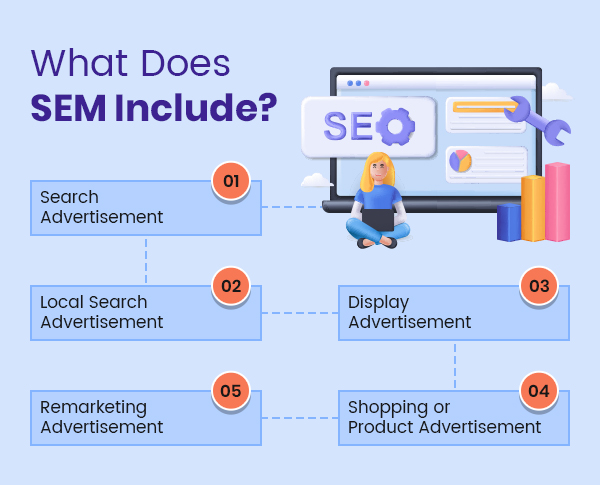
➢ Unlocking the Power & Purpose of SEM
The goal of SEM is crystal clear. With SEO, we aim to attract visitors to the website organically. However, when we use SEM, we aim for a wider audience to increase sales while the website is compensated to rank highly. This will encourage customers to learn more about your brand and its offerings.
Now, how do we do this?
There are several ways to fulfill the purpose of SEM. They are listed below:
➢ Keyword Research
Good keyword research is essential for a successful campaign since it makes sure to target the right audience searching for a similar keyword and increases the visibility of your website on search engine results pages.
➢ Campaign Structure
A campaign structure refers to the organized framework and hierarchy businesses and marketers use to plan, manage, and execute their marketing and advertising efforts across various channels. It provides a systematic approach to organizing and optimizing marketing campaigns to achieve specific goals and objectives.
Campaign structure is particularly important in digital marketing, where multiple channels, platforms, and strategies are often used simultaneously. The specific structure of a campaign can vary depending on its purpose, industry, and target audience.
Regardless of the type of campaign, a well-organized and strategic approach is crucial for achieving desired outcomes and maximizing the return on investment.
➢ Budgeting
Setting a budget is essential for any campaign to ensure you don’t overspend and make the most of the allotted funds.
➢ Monitoring and Analysis
Monitoring the growth of your campaign is essential to ensure that it aligns with your strategic plan and achieves your overarching goal. By closely tracking its progress and performance, you can make timely adjustments, optimize resources, and address any issues that may arise, ultimately increasing the likelihood of success.
This continuous monitoring and flexibility are key to effectively managing and guiding your campaign toward the intended goal. You may monitor the main indicators through analytical tools like CTR, CPC, and other relevant metrics on various advertising platforms.
Also Read: Does Buying Traffic To Your Website Work?
➢ How Does SEM Work?
SEM can be a highly effective way to drive targeted traffic to your website and achieve specific marketing goals. However, it is possible through preparation, constant supervision, and a budget for paid advertising.
The first stage in this procedure involves identifying the keywords that potential customers frequently use when looking for the goods or services they need. The advertiser then buys advertising space for these terms on search engine platforms.
Pay-per-click (PPC) advertising is a payment model where the advertiser pays back the search engine provider for each click on their advertisement. This strategy guarantees that the advertiser’s material is shown to those actively looking for relevant data or products, making it an effective and targeted marketing strategy.
To guarantee that your SEM campaigns continue to be successful, staying up to date with changes in search engine algorithms and advertising platforms is critical.
➢ The Astonishing Benefits of SEM
Search Engine Marketing (SEM) offers several key benefits for businesses. Firstly, SEM enables companies to effectively target individuals by conducting ad campaigns using popular and relevant keywords.
The possibility of conversions increases with targeted ads displayed to prospective customers actively looking for goods or services.
Businesses have the best chance to attract potential consumers’ attention at the ideal time in their purchasing journey when the advertisements appear prominently in the search results when a user types in a search query matching the keywords in an SEM campaign.
This speed and relevancy lead to a greater conversion rate than many other marketing channels.
How SEO and SEM Complement Each Other?
SEO and SEM are two different ways to make your website appear at the top of Google when people search for something. They both aim to get more people to visit your website.
Think of it like this: You have a store and want many people to buy your products. SEO and SEM can help you attract customers to your store.
SEO (Search Engine Optimization): This is like making your store look appealing and organized so that people walking by are more likely to come in. You do things like using the right keywords on your website, creating high-quality content, and getting other websites to link to yours. These things help your website show up in Google search results without you paying for ads.
SEM (Search Engine Marketing): This is like putting up a big sign outside your store with a special offer to attract customers. You pay Google to show your website at the top of search results when people search for specific keywords. It’s a way to get quick attention and bring in customers, but you must pay for it.
Despite their diverse features, the main objective of both SEO and SEM is to attain a desired goal.
➢ Comprehensive Search Visibility
To make sure that your digital presence is easily discovered across multiple search engines and platforms, improving comprehensive search visibility requires an extensive strategy.
Firstly, optimizing your website for search engines (SEO) is essential. This entails conducting in-depth keyword research to find relevant terms and expressions your target audience will look up online. Strategically include these keywords in your website’s text, meta descriptions, and headings.
Additionally, focus on producing interesting, informative content that speaks to your audience and search engines. Ensure your website is mobile-friendly, loads quickly, and is technically sound to provide a seamless user experience.
Enhancing the user experience and structure and acquiring high-quality backlinks from trustworthy websites will significantly improve search results.
Furthermore, don’t neglect the importance of a strong presence on social media and other online platforms. Regularly share and promote your content across social media channels, creating a base of followers and engagement that can drive traffic back to your website.
Utilizing paid advertising, like Google Ads, and taking the benefits of email marketing campaigns can also increase your presence in search results. Evaluating your progress, making decisions based on data, and changing your plan over time by employing analytics tools to monitor your performance are important.
Combining these strategies and staying up-to-date with the latest SEO trends and algorithm updates can enhance your comprehensive search visibility and increase your chances of reaching a broader online audience.
Also Read: Does SSL Help SEO? Discover Eye-Opening Insights
➢ Faster Results
Bringing together SEO and SEM can help you get results more quickly in various ways. SEM offers rapid traffic and leads, but SEO concentrates on steady, organic growth over time. To reap the advantages of each, the key is to combine both techniques, share information, and continuously improve your digital marketing strategy.
The websites can expect a larger target audience than normal, with SEO and SEM working as joint forces to increase the reach and deliver a fantastic user experience, leading to faster results.
➢ Getting More Data Synergy and Insights
SEO and SEM work best together by offering useful information and insights that may be used to improve both tactics. You may develop a more successful and comprehensive digital marketing strategy by utilizing the data synergy between these two methods.
For brands to get results, it’s important to balance SEO and SEM that enable websites to rank first, attract more attention from users, and employ various amazing SEO tools to maximize growth.
➢ Increase CTR
By performing in-depth keyword research, writing attractive and relevant meta descriptions and titles, developing high-quality & engaging content, implementing negative keywords to filter out irrelevant traffic, utilizing ad extensions to provide more information, and many other types of SEO and SEM strategies, you can boost the Click Through Rate and meet your desired goal.
It is essential to track and evaluate performance measures. Review your CTR data frequently, keep tabs on modifications, and make necessary corrections to boost your CTR rates over time. Optimizing for CTR is just one component of a full digital marketing plan; SEO and SEM are continual initiatives.
➢ Create a Strong Brand Presence
Combining SEO and SEM can strengthen your brand and enhance your online presence. SEM enables you to maintain brand consistency across numerous channels as you have complete control over the content of advertising and graphics. Meanwhile, SEO helps create a reliable digital identity that promotes your brand and credibility.
Combining these tactics may improve your online presence, uphold brand consistency, use data effectively, and accomplish short-term and long-term marketing objectives. Combining SEO and SEM may build a powerful and enduring brand in the competitive digital environment.
➢ Maximizing Keyword Coverage
SEM enables you to swiftly broaden your keyword coverage, whereas SEO normally targets a core group of keywords. You can bid on a wider variety of keywords with SEM, including long-tail and extremely competitive ones that would be challenging to rank organically soon.
You can maximize your keyword coverage, enhance your online visibility, and drive more targeted traffic to your website. You may develop a comprehensive search engine marketing plan that yields the best results for your company by utilizing the advantages of both strategies and exchanging knowledge between them.
You can leverage SEO to connect with more people if you’re a new brand with a limited marketing budget. You may build your business and organically increase website traffic by focusing on as many keywords as possible.
Let’s have a recap of what we learned about working of SEO & SEM together with an infographic below:
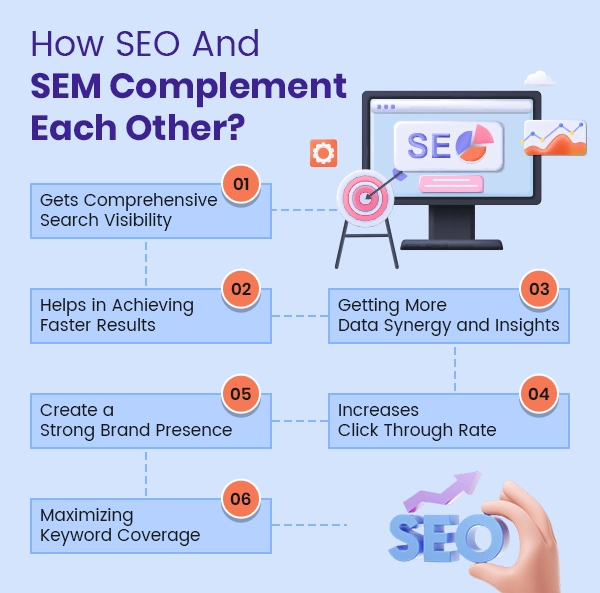
Also Read: How Many Keywords Can A Website Have For SEO?
Frequently Asked Questions (FAQs)
While SEO focuses on your most crucial keywords to rank first, SEM needs to pay attention to other elements of the paid process. To increase traffic to the website, SEM should take advantage of keywords that are not generating organic traffic.
In order to maximize their online presence in search results, SEO tactics are typically focused on the target audience and demographics. SEM tactics are centered on click-through rates, average PPC, and Google Analytics, which use the data to assess their success and rely on those results to engage their target audience further.
Tracking your performance is crucial, whether using paid advertising or organic methods to bring in customers. You can use various methods to monitor your success, such as top query analytics, page metrics, and click-through rates.
There are numerous ways to monitor your performance and tweak it to work best for your brand.
There are several industries, and they are all unique from one another. Numerous competitors are searching for a breakthrough and the top rank even within the same industry. Making a niche-specific, one-of-a-kind marketing plan is the key to achieving that.
There are certain misconceptions about SEM and SEO, even though utilizing SEM methods does not affect SEO.
It is erroneous to believe rankings are the only factors that matter when engaging in these marketing efforts. That more traffic equates to greater success is a related misconception. False! Users can always visit your website to generate traffic, but this does not guarantee increased purchases.
It is advisable to avoid falling for these assumptions and concentrate on boosting the value of your brand by using unique advertising techniques that are suitable for your company.
Integrating SEO and SEM into your small business strategy can improve high-quality traffic, bringing prospective consumers to your website. Additionally, it may help you score highly in the ranking game and enhance the market value of your brand.
Conclusion
As technology develops, there will be countless advancements in the marketing sector. Keeping up with these features depends on how your target audience perceives your brand.
As an integral component of a marketing strategy, SEO and SEM will always help enhance organic traffic and paid advertisements and promote brand awareness among the target audience.
